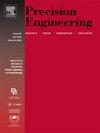高精度球坐标扫描测量系统大型标定标准装置的研制
IF 3.7
2区 工程技术
Q2 ENGINEERING, MANUFACTURING
Precision Engineering-Journal of the International Societies for Precision Engineering and Nanotechnology
Pub Date : 2025-03-27
DOI:10.1016/j.precisioneng.2025.03.030
引用次数: 0
摘要
高精度球坐标扫描测量系统(HP-SCSMSs)的迅速发展,极大地提高了飞机机翼、机身、火箭体、风力涡轮机叶片等复杂曲面零件轮廓测量的效率和精度。然而,hp - scsms的校准和性能评估仍然具有挑战性,因为内部几何误差和外部误差源都可能导致三维点云的不准确性。为了解决这些挑战,设计并组装了一个大型曲面标准装置。该设备为评价hp - scsms提供了物理参考,便于hp - scsms的综合校准。本文详细介绍了标准装置的设计、组装和验证。在设计阶段,仔细考虑了表面形状和表面面板的调整策略,以确保设备能够模拟各种扫描对象和条件。为了减轻温度变化对测量精度的影响,采用了创新的独立悬架和径向导向结构,有效降低了热变形的影响。在装配过程中,采用先进的高精度测量技术,确保每个组件的精确对准和稳定性。最后,为了验证标准装置的长期稳定性,在九个月的时间里,使用激光跟踪器对其凹面板进行了三次测量。实测数据与先前构建的模型进行了比较,显示最大均方根(RMS)为0.009 mm。研制的大型标准装置为hp - scsms的评估和校准提供了可靠的标准,解决了内部和外部的误差源,为hp - scsms的行业标准的制定和完善奠定了基础。本文章由计算机程序翻译,如有差异,请以英文原文为准。
Development of a large-scale standard device for calibration of high-precision spherical coordinate scanning measurement systems
The rapid advancement of high-precision spherical coordinate scanning measurement systems (HP-SCSMSs) has significantly improved the efficiency and accuracy of profile measurements for complex curved parts, such as aircraft wings, fuselages, rocket bodies, and wind turbine blades. However, the calibration and performance evaluation of HP-SCSMSs remain challenging, as both internal geometric errors and external error sources can contribute to inaccuracies in the resulting 3D point clouds. To address these challenges, a large-scale curved surface standard device has been designed and assembled. This device provides a physical reference for evaluating HP-SCSMSs and facilitates comprehensive calibration of HP-SCSMSs. This paper details the design, assembly, and verification of the standard device. During the design phase, the careful consideration is given to the surface shape and the adjustment strategy for the surface panels to ensure the device could simulate a variety of scanning objects and conditions. To mitigate the effects of temperature changes on measurement accuracy, an innovative independent suspension and radial guide structure is implemented, effectively reducing the impact of thermal deformation. During assembly, advanced high-precision measurement techniques are employed to ensure the precise alignment and stability of each component. Finally, to verify the long-term stability of the standard device, three measurements of its concave panel using a laser tracker are taken over a period of nine months. The measured data are compared with the previously constructed model, showing a maximum Root Mean Square (RMS) of 0.009 mm. The developed large-scale standard device provides a reliable standard for evaluating and calibrating HP-SCSMSs, addressing both internal and external error sources, and lays the groundwork for the development and refinement of industry standards for HP-SCSMSs.
求助全文
通过发布文献求助,成功后即可免费获取论文全文。
去求助
来源期刊
CiteScore
7.40
自引率
5.60%
发文量
177
审稿时长
46 days
期刊介绍:
Precision Engineering - Journal of the International Societies for Precision Engineering and Nanotechnology is devoted to the multidisciplinary study and practice of high accuracy engineering, metrology, and manufacturing. The journal takes an integrated approach to all subjects related to research, design, manufacture, performance validation, and application of high precision machines, instruments, and components, including fundamental and applied research and development in manufacturing processes, fabrication technology, and advanced measurement science. The scope includes precision-engineered systems and supporting metrology over the full range of length scales, from atom-based nanotechnology and advanced lithographic technology to large-scale systems, including optical and radio telescopes and macrometrology.

 求助内容:
求助内容: 应助结果提醒方式:
应助结果提醒方式:


